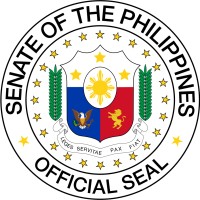
Senate Of The Philippines
Get verified emails for Senate Of The Philippines employees

About Senate Of The Philippines

|
|

|
501-1,000 employees
View all

|

|
Legislative Office
|

|
Financial Center,Diokno Boulevard,Pasay,PH
|

|
The 1972 Constitution abolished the bicameral legislature and in its stead established a unicameral body under a parliamentary government. The legislative bodies created during the martial law were the Batasang Bayan, the Interim Batasang Bayan and the Batasang Pambansa. When the popular “people power” or EDSA revolution broke out in February, 1986, Corazon Aquino was installed as the new President. She issued a proclamation creating a Constitutional Commission to draft a new Constitution for the Philippines.
The said commission convened on June 1, 1986, and finished its work on October 15, 1986. A plebiscite, held on February 7, 1987, overwhelmingly ratified the present 1987 Constitution. The 1987 Constitution restored the presidential system of government together with the bicameral congress of the Philippines. Section 1, Article VI of the 1987 Constitution provides as follows:
The legislative power shall be vested in the Congress of the Philippines, which shall consist of the Senate and the House of Representatives, except to the extent reserved to the people by the provision on initiative and referendum.
The present Congress is actually a reincarnation of the Senate of the Philippines under the 1940 amendment to the 1935 Constitution. As mandated by the new constitution, the upper chamber is composed of 24 members elected at large, who serve a term of six years. Senators cannot serve beyond two consecutive terms.
The Senate of the 16th Congress is currently headed by Senate President Franklin M. Drilon, Pro Tempore Ralph Recto, Majority Leader Allan Peter "Compañero" S. Cayetano and Minority Leader Juan Ponce Enrile . It has thirty-six (36) permanent committees and five (5) Oversight committees to fuel the wheels of the legislative mill. The Senate or any of its committees may conduct formal inquiries or investigations in aid of legislation. The committees are classified into: (1) standing or permanent; (2) special or ad hoc; (3) joint; and (4) sub. Subcommittees are created to parcel the work of standing or special committees. The "special" committees are created for a particular purpose and dissolved after accomplishing such purpose. Joint committees are those that include members of both houses.
|
Senate Of The Philippines Email Format
The widely used Senate Of The Philippines email format is {last}@senate.gov.ph (e.g. [email protected]), which is used 75% of the time.
| Senate Of The Philippines Email Formats | Example Email Formats | Percentage |
|---|---|---|
| {last} | [email protected] |
75%
|
Frequently Asked Questions about Senate Of The Philippines
What is Senate Of The Philippines email format?
The widely used Senate Of The Philippines email format is {last} (e.g. [email protected]) with 75% adoption across the company.
What is Senate Of The Philippines customer service number?
To contact Senate Of The Philippines customer service number in your country click here to find.
Senate Of The Philippines Staff Directory
Search Senate Of The Philippines Staff Directory
Find accurate personal emails, work emails and phone numbers for employees
Supercharge your
Prospecting &
Outreach with
ContactOut
Supercharge your Prospecting &
Outreach with ContactOut
Search Portal
Find countless prospects outside of LinkedIn fast
Accelerate prospecting with instant access to 300M professionals from 30M companies with the right contact details.














